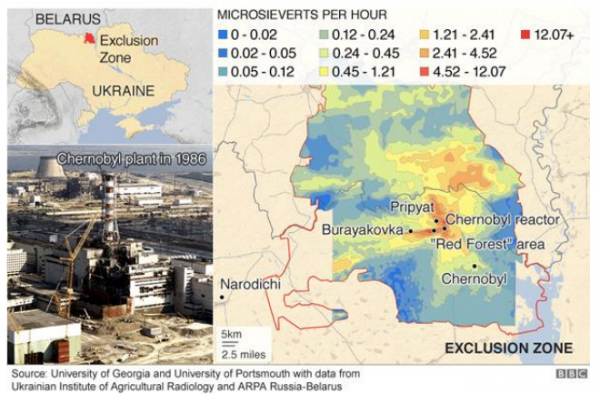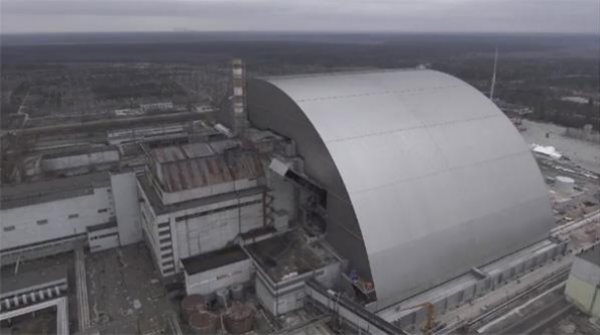TCHERNOBYL (2021)
Chernobyl more than 30 years after the accident
More than 30 years later, the Chernobyl accident is still very present in the public mind. In 2019, a television series of English origin (HBO/Sky) was a great success. Reality and fiction were mixed in the facts description.
Radiation rates today
What is the real situation today? The short-lived radioelements have disappeared. The two main fission products, cesium-137 and strontium-90, have decreased by half. What is the residual radioactivity in the contaminated area? In 2019, the BBC published a recent map of radiation levels within the Chernobyl exclusion zone.

2019: Radiation levels in the exclusion zone of Chernobyl.
Extracted from this objective coverage, the map shows a radiation rate that has become low over a large part of the zone, often lower than the natural radioactivity rate which in France is 0.3 microSv/hour. Nevertheless, there are still hot spots, especially in the red forest, a part of the forest that received most of the rain of radioactive materials in 1986 because of the winds. The radiation rate peaks there at 35-40 microSv/hour.
LINK TO TWO BBC ARTICLES
– Chernobyl survivors evaluate fact and fiction in TV series (June 2019)
– Report on radiation levels around Chernobyl (February 2019)
On the site of the power plant
On the site of the power plant itself, a large arch now covers the sarcophagus that was meant to contain the radioactive material from the destroyed reactor. Built in six months after the accident, this sarcophagus has since rapidly deteriorated. The installation of a large covering arch was completed in December 2018. It is designed to prevent the dispersion of radioactive contaminants, water intrusion, to protect the reactor and allow its dismantling.

Chernobyl’s Great Arch overlooking the damaged reactor and its sarcophagus. @Wikipdeia
The Chernobyl plant was located in a sparsely populated area. After the accident, an exclusion zone was defined to be returned to nature, where vegetation and animal took the place of humans. This no-man’s land has become in thirty years a reserve teeming with life and full of wild animal species that prevail. Sometimes fires occur in the wooded area, but the fire of 2020, contrary to fears, did not cause any significant dispersion of radioactivity
The area around the plant, including the abandoned town of Prypiat, is now well cleaned up. A new kind of tourism is flourishing, and there is no shortage of visitors to the site, often equipped with Geiger counters.
For more information, see :
– Construction of a large arch to protect the sarcophagus (page pending translation)